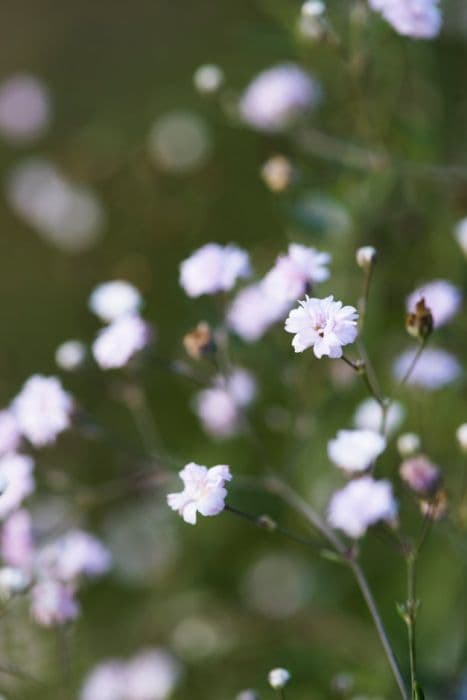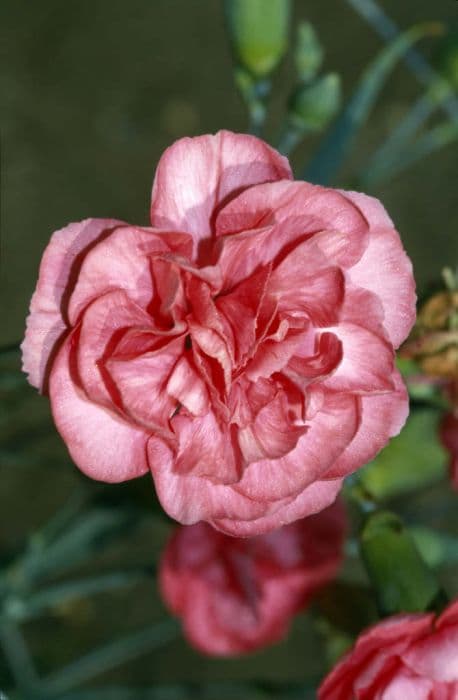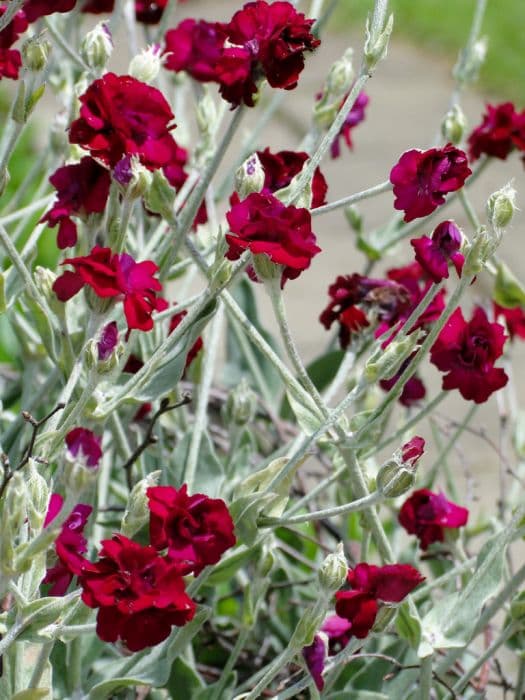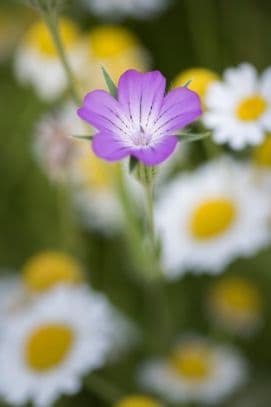Sweet William Dianthus barbatus

ABOUT
Dianthus barbatus, commonly known as Sweet William, is a perennial plant characterized by its vibrant, colorful flowers and attractive foliage. The flowers of Sweet William have a dense cluster formation, known as a cyme, and feature a wide range of colors including pink, red, white, and sometimes bicolored patterns. Each small flower within the cluster has five petals with serrated or fringed edges, which give them a distinctive, slightly ruffled appearance. The petals often exhibit a velvety texture and may have a subtle, spicy fragrance that's particularly noticeable in the early morning and evening. The leaves of Sweet William are lance-shaped, meaning they are long and narrow with a pointed tip. They are typically a medium to dark green in color and have a smooth texture with a slightly waxy surface. These leaves form a dense basal rosette at the base of the plant, and as the flowering stems rise, the leaves become smaller and more sparse. Sweet William's overall growth habit gives it a full, bushy appearance, and its striking flower clusters create a showy display that can add significant visual interest to garden beds, borders, and containers. It is a popular choice in temperate gardens for its pleasant appearance and ease of care.
About this plant
 Names
NamesFamily
Caryophyllaceae
Synonyms
Sweet William, Bunch Pink
Common names
Caryophyllus barbatus, Cylichnanthus barbatus, Dianthus caryophyllus var. barbatus, Dianthus caesius, Dianthus compactus, Dianthus praecox, Dianthus praecox var. compactus, Dianthus praecox var. nanus, Dianthus pumilus, Dianthus rupicola, Dianthus silvester, Dianthus tunicatus, Silene barbata.
 Toxicity
ToxicityTo humans
The plant Dianthus barbatus, commonly known as Sweet William, is not considered toxic to humans. Therefore, ingesting parts of Sweet William typically does not lead to poisoning or exhibit symptoms associated with toxic plants.
To pets
Sweet William is also not considered toxic to pets. It is not known to cause significant symptoms of poisoning or dangerous consequences if pets ingest parts of the plant. However, it is always prudent to monitor pets for any unusual reactions after ingesting plants as individual sensitivities can vary.
 Characteristics
CharacteristicsLife cycle
Biennials
Foliage type
Deciduous
Color of leaves
Green
Flower color
Varies
Height
1-2 feet (30-60 cm)
Spread
1 foot (30 cm)
Plant type
Herb
Hardiness zones
3-9
Native area
Europe
Benefits
 General Benefits
General Benefits- Aesthetic Appeal: Dianthus barbatus, commonly known as Sweet William, adds vibrant colors and intricate patterns to gardens, which can enhance the overall visual appeal of the landscaping.
- Pollinator Attraction: Sweet William flowers attract beneficial insects such as butterflies and bees, supporting pollination of surrounding plants.
- Scent: The fragrant blossoms of Sweet William can perfume an outdoor area, providing a pleasant, sweet smell.
- Cut Flowers: The long-lasting blooms make excellent cut flowers for bouquets and floral arrangements.
- Easy to Grow: Sweet William is known for being easy to cultivate, even for novice gardeners, due to its hardiness and minimal care requirements.
- Versatility: Sweet William is suitable for a variety of garden designs, including borders, rockeries, and container gardens.
- Seasonal Interest: Sweet William typically blooms in late spring to early summer, adding seasonal interest to gardens.
 Medical Properties
Medical Properties- Antibacterial: Dianthus barbatus has been traditionally used for its antibacterial properties to help treat infections.
- Diuretic: The plant has diuretic effects, which means it can promote the production of urine, aiding in the removal of excess water and salts from the body.
- Anti-inflammatory: Some herbal practitioners use Dianthus barbatus for its anti-inflammatory properties to alleviate inflammation.
- Digestive aid: It has been used historically to aid digestion and treat gastrointestinal discomfort.
 Air-purifying Qualities
Air-purifying QualitiesThis plant is not specifically known for air purifying qualities.
 Other Uses
Other Uses- Dianthus barbatus, commonly known as Sweet William, is used in traditional costumes and festive garb, particularly in central European cultures where its flowers are used to adorn hats and clothing during folk festivals.
- In floral language and symbolism, Sweet William is often used in bouquets and floral arrangements to convey a message of gallantry or finesse, making it a popular choice for weddings and courtship displays.
- Culinary artists sometimes use the petals of Sweet William as an edible decoration for cakes and pastries, adding a splash of color and a mild spicy flavor reminiscent of cloves.
- The vibrant petals of Sweet William can be used to make natural dyes for fabrics and textiles, giving a range of colors from soft pinks to deep purples.
- Gardeners plant Sweet William as a companion plant to vegetables, such as tomatoes, because its strong scent is believed to deter pests like aphids and improve overall plant health.
- Sweet William is included in potpourri mixtures for its pleasant fragrance, which can freshen up living spaces without the use of synthetic air fresheners.
- Sweet William's dense cluster of flowers provides a decorative natural mulch for garden beds, helping to retain soil moisture and suppress weeds when its blooms have faded.
- The flowers are sometimes used in crafting, pressed or dried, to create botanical art pieces, greeting cards, or bookmarks for a unique, natural touch.
- Children's educational activities, such as science projects on plant biology or art classes, can incorporate Sweet William for hands-on learning about flower structure and pigmentation.
- In some cultural ceremonies, Sweet William is used as a tribute flower, symbolizing bravery and honor when placed on memorials or gravesites.
Interesting Facts
 Feng Shui
Feng ShuiSweet William is not used in Feng Shui practice.
 Zodiac Sign Compitability
Zodiac Sign CompitabilitySweet William is not used in astrology practice.
 Plant Symbolism
Plant Symbolism- Affection: Dianthus barbatus, commonly known as Sweet William, often represents a symbol of affection due to its charming and colorful clusters of flowers.
- Boldness: The vibrant and diverse colors seen in Sweet William blooms are often linked to a boldness or daring character in the language of flowers.
- Finesse: Sweet William's intricate and delicate patterned flowers symbolize finesse, often admired for their elegance in floral arrangements.
- Perseverance: Due to the plant's hardy nature, it is also associated with perseverance, capable of thriving in a variety of conditions.
- Granting of Smiles: As a cheerful and bright plant, Sweet William is sometimes connected to the idea of granting smiles to the recipient of the flowers.
- Gallantry: The name "Sweet William" itself evokes a sense of gallantry and is even sometimes associated with the historical figure Prince William, which may contribute to its symbolic representation of nobility and bravery.
 Water
WaterSweet William should be watered deeply but infrequently to encourage strong, deep root development. Typically, you can water these plants once a week, providing about 1 to 1.5 inches of water each time. During hot, dry spells, you may need to increase watering to twice a week, ensuring that the soil is moist but never soggy. Reduce the frequency to every two weeks in cooler, wet weather. It's essential to avoid overhead watering to prevent disease; water at the soil level instead.
 Light
LightSweet William thrives in full sunlight, requiring at least six to eight hours of direct sunlight daily for optimal growth and blooming. It can tolerate partial shade, especially in hotter climates where some afternoon shade can protect it from the intense heat. Ideally, place Sweet William in a spot where it's exposed to morning light and partial afternoon shade to maintain vibrant colors and healthy growth.
 Temperature
TemperatureSweet William prefers moderate temperatures and will flourish best when daytime temperatures are between 60°F and 70°F. It can survive minimum temperatures of 40°F, making it suitable for cooler climates. However, to ensure the plant's health, it's crucial to protect it from extreme cold and frost. Sweet William can tolerate up to a maximum temperature of around 80°F, beyond which the plant may experience stress.
 Pruning
PruningSweet William should be pruned to remove dead or spent flowers, a practice known as deadheading, which encourages further blooming and prevents the plant from self-seeding excessively. Prune the plant back by one-third after the blooming season to maintain a compact shape and promote fresh growth. The best time for more extensive pruning is in early spring or after the plant has finished its main flowering period.
 Cleaning
CleaningAs needed
 Soil
SoilSweet William thrives in loamy, well-draining soil with a neutral to slightly alkaline pH between 6.5 and 7.5. A mix of two parts garden soil, one part compost, and one part perlite or sand is ideal to ensure proper drainage and fertility.
 Repotting
RepottingSweet William doesn't typically require frequent repotting. It is best to repot every 2-3 years or when it becomes root-bound to ensure continued growth and health.
 Humidity & Misting
Humidity & MistingSweet William tolerates a wide range of humidity levels but prefers average to low humidity, typical of outdoor conditions. Indoors, it does not require any special humidity adjustments.
 Suitable locations
Suitable locationsIndoor
Place Sweet William in a sunny spot with good airflow.
Outdoor
Plant in full sun to partial shade, in well-drained soil.
Hardiness zone
3-9 USDA
 Life cycle
Life cycleDianthus barbatus, commonly known as Sweet William, begins its life cycle with seed germination, which takes place in late spring or early summer, requiring a period of cold stratification to break dormancy. After germination, the plant enters the vegetative stage, developing a rosette of leaves close to the ground throughout the first growing season. In the second year, Sweet William produces flowering stems bearing clusters of fragrant flowers in a wide range of colors, typically in late spring to early summer. After pollination, which is often aided by insects attracted to the flowers' nectar and color, the plant sets seed in capsule-like fruits. Once seeds mature, they are dispersed from the parent plant to start new plants, completing the sexual reproduction cycle. Eventually, after flowering and seed setting, the biennial Sweet William typically dies, although some plants can behave as short-lived perennials, coming back for more than two seasons.
 Propogation
PropogationPropogation time
Spring-Early Summer
Propogation: Sweet William, known botanically as Dianthus barbatus, is commonly propagated through seeds as this method is both popular and effective. The best time to sow Sweet William seeds is usually in late spring to early summer or in autumn, depending on the climate of the area. Seeds are typically sown directly onto well-drained soil in a sunny location. When starting seeds indoors, they should be started about 6-8 weeks before the last frost date. It's important to lightly cover the seeds with soil as they require darkness for optimum germination, which takes place in 7-14 days at a temperature of around 70 degrees Fahrenheit (about 21 degrees Celsius). Once seedlings emerge and grow sufficiently, they can be thinned out or transplanted to their final location. This method allows gardeners to cultivate a large number of plants efficiently while maintaining the diverse color variations that Sweet William is known for.








